|
(11) | EP 0 293 548 B1 |
| (12) | EUROPEAN PATENT SPECIFICATION |
|
|
| (54) |
Mono- and diepoxide derivatives of LL-F28249 compounds Mono- und Diepoxid-Derivate von LL-F28249-Verbindungen Dérivés mono- et diépoxide des composés LL-F28249 |
|
|
|||||||||||||||||||||||||||||||
| Note: Within nine months from the publication of the mention of the grant of the European patent, any person may give notice to the European Patent Office of opposition to the European patent granted. Notice of opposition shall be filed in a written reasoned statement. It shall not be deemed to have been filed until the opposition fee has been paid. (Art. 99(1) European Patent Convention). |
BACKGROUND OF THE INVENTION
[0001] The present invention relates to new mono-and diepoxide derivatives of the compounds collectively defined as LL-F28249. These LL-F28249 antibiotics preferably are produced by the fermentation of the microorganism Streptomyces cyaneogriseus subspecies noncyanogenus, deposited in the NRRL under deposit accession No. 15773. The morphological characteristics of this culture, compounds and method for their production are disclosed in European Patent Application No. 170,006, incorporated herein by reference.
[0002] The LL-F28249 components are complex macrolids which have 5 olefinic bonds. The regioselective epoxidation of the C(26,27)-olefinic bond concomitant with or without epoxidation at the C(14,15)-olefinic bond is the subject matter of the instant application. These mono- and diepoxide derivatives possess anthelmintic, ectoparasitic, insecticidal, acaricidal and nematicidal activity and, therefore, are useful in the prevention, control or treatment of infections in warm-blooded animals, as well as infestations of agricultural crops.
SUMMARY OF THE INVENTION
[0003] The present invention provides novel C(26,27)-epoxide and C(14,15; 26,27)-diepoxide derivatives of the compounds designated LL-F28249α, β, ε, ζ, ϑ and
.
[0005] The compounds of the present invention are useful anthelmintics, ectoparasiticides, insecticides, acaricides and nematicides in treating, preventing or controlling such diseases in warm-blooded animals, such as poultry, cattle, sheep, swine, rabbits, horses, dogs, cats and human beings and agricultural crops.
[0006] Although these diseases have been recognized for years and therapies exist for the treatment and prevention of the diseases, the present invention provides novel compounds in the search for effective such therapy. For instance, U.S. Application for Letters Patent Serial Numbers 907,283, 907,188, 907,281, 907,259, 907,187 and 907,284 of Asato and Asato et al, filed on September 12, 1986 and incorporated herein by references thereof provide compounds for such treatments. European Patent Application 0 136 892 describes avermectin epoxide derivatives wherein at least one of the 8,9 and 14,15 positions is epoxidized.
[0007] Non-prepublished EP-0 241 146 describes macrolide compounds including D¹⁴, D²⁶ bisepoxides and D²⁶-epoxides.
[0008] U.S. Patent 3,950,360, Aoki et al, April 13, 1976 discloses certain antibiotic substances obtained by culturing a Streptomyces microorganism, said compounds being useful as insecticides and acaricides. Further, an entire series of U.S. patents relates to certain compounds produced by the fermentation of Streptomyces avermitilis (U.S. Patent 4,171,314, Chabala et al, October 16, 1979; U.S. Patent 4,199,569, Chabala et al, April 22, 1980; U.S. Patent 4,206,205, Mrozik et al, June 3, 1980; U.S. Patent 4,310,519, Albers-Schonberg, January 12, 1982; U.S. Patent 4,333,925, Buhs et al, June 8, 1982). U.S. Patent 4,423,209, Mrozik, December 27, 1983 relates to the process of converting some of these less desirable components to more preferred ones. Finally, British Patent Application No. 2166436 A discloses antibiotics also, as does Belgium Patent Application 904,709A.
[0009] The present compounds or the pharmaceutically and pharmacologically acceptable salts thereof exhibit excellent and effective treatment, prevention and/or control of these serious diseases of warm-blooded animals.
[0010] It is an object of the present invention, therefore, to provide novel C(26,27)-epoxide and C(14,15; 26,27)-diepoxide derivatives of LL-F28249α, β, ε, ζ, ϑ and
. It is a further object to provide a process for the preparation of these derivatives and to provide methods for preventing, treating or controlling endo- and ectoparasitic (collectively parasitic) insect, nematode and acarid infections and infestations in warm-blooded animals and agricultural crops by providing compositions containing prophylactically, therapeutically, pharmaceutically or pesticidally effective amounts of the present compound. A further object of these compounds is as intermediates for the preparation of other novel antiparasitic and insecticidal compounds.
[0011] These and other objects of the invention will become apparent by the more detailed description of the invention provided hereinbelow.
DETAILED DESCRIPTION OF THE INVENTION
[0012] The LL-F28249 compounds which may act as precursors of the present compounds are represented by the following structural formula,
[0013] The compounds of the present invention are represented by the following structural formula,
wherein R₁ is methyl or isopropyl; R₂ is hydrogen, or ethyl; and the dotted triangular figure with oxygen at C(14,15) indicates that either a double bond or an epoxide is present.
[0014] The monoepoxide and diepoxide compounds of the present invention are prepared by treating the appropriately-protected LL-F28249 compound with an oxidizing agent at temperature less than -15°C. The oxidant useful in the present invention is capable of selectively oxidizing the C(26,27) double bond, as well as the C(14,15) double bond, but will leave other double bonds in the molecule intact. Selectivity also is attained by controlling the temperature of the oxidation in an inert solvent, such as methylene chloride, chloroform and the like. Peroxide oxidizing agents, such as m-chloroperoxybenzoic acid, are representative of the preferred oxidants in preparing the monoepoxy and diepoxy compounds of the present invention.
[0015] Generally, a slight excess of the oxidizing agent is employed, such as 5%-20% excess, when it is desired to prepare the C(26,27) epoxide in good yield. When epoxidation at C(14,15) double bond also is desired, equivalent to a slight excess of 2 moles is employed. These epoxides are readily separated by standard chromatographic techniques, such as column or preparative-plate chromatography.
[0016] The epoxidation also is generally conducted at temperatures less than -20°C to -78 °C and is complete in 3-6 hours. Separation of the monoepoxide from the diepoxide is readily achieved by standard chromatographic techniques, such as column or preparative-plate chromatography.
[0017] The starting materials for the compounds of the present invention are the above-mentioned LL-F28249 fermentation products. These compounds are initially derivatized at the 5- and 23-hydroxy groups with a trisubstituted alkyl silyl group. A preferred protecting group is t-butyldimethylsilyl group. The reaction is carried out by allowing the LL-F28249 compound to react with two molar equivalents of a substituted silyl halide, preferably a silyl chloride, in an aprotic solvent such as dimethylformamide or ethylene dichloride in the presence of imidazole and/or 4-dimethylaminopyridine. The reaction is completed in 2-8 hours at 50°C to 80°C.
[0018] The silyl groups are removed after epoxidation by stirring the silyl derivative in methanol containing an acid, such as p-toluenesulfonic acid monohydrate or acetic acid without methanol. The reaction is complete in 1-8 hours at 0°C to 25°C, preferably at 10° C to 25°C. It also is especially beneficial if this reaction is conducted in the presence of catalytic amount of FeCl₃.
[0019] The novel compounds of the present invention possess significant parasitical activity as anthelmintics, ectoparasiticides, insecticides, nematicides and acaricides, in human and animal health and in agriculture.
[0020] The disease or group of diseases described generally as helminthiasis is due to infection of an animal host with parasitic worms known as helminths. Helminthiasis is a prevalent and serious economic problem in domesticated animals such as swine, sheep, horses, cattle, goats, dogs, cats and poultry. Among the helminths, the group of worms described as nematodes causes widespread and often times serious infection in various species of animals. The most common genera of nematodes infecting the animals referred to above are Haemonchus, Trichostrongylus, Ostertagia, Nematodirus, Cooperia, Ascaris, Bunostomum, Oesophagostomum, Chabertia, Trichuris, Strongylus, Trichonema, Dichtyocaulus, Capillaria, Heterakis, Toxocara, Ascaridia, Oxyuris, Ancylostoma, Uncinaria, Toxascaris and Parascaris. Certain of these, such as Nematodirus, Cooperia, and Oesphagostomum, primarily attack the intestinal tract while others, such as Haemonchus and Ostertagia, are most prevalent in the stomach, while still others such as Dictyocaulus are found in the lungs. Still other parasites may be located in other tissues and organs of the body such as the heart and blood vessels, subcutaneous and lymphatic tissue and the like. The parasitic infections known as helminthiases lead to anemia, malnutrition, weakness, weight loss, severe damage to the walls of the intestinal tract and other tissues and organs and, if left untreated, may result in death of the infected host. The compounds of this invention have unexpectedly high activity against these parasites, and in addition are also active against Dirofiliara in dogs, Nematospiroides, Syphacia, Aspiculuris in rodents, arthropod ectoparasites of animals and birds such as ticks, mites, lice, fleas, blowfly, in sheep Lucilia sp., biting insects and such migrating dipterous larvae such as Hypoderma sp., in cattle, Gastrophilus in horses, and Cuterebra sp., in rodents.
[0021] The compounds of the present invention also are useful in treating, preventing or controlling parasites which infect human beings, as well. The most common genera of parasites of the gastrointestinal tract of man are Ancylostoma, Necator, Ascaris, Strongyloides, Trichinella, Capillaria, Trichuris and Enterobius. Other medically important genera of parasites which are found in the blood or other tissues and organs outside the gastrointestinal tract are the filiarial worms such as Wuchereria, Brugia, Onchocerca and Loa, Bracunculus and extra-intestinal stages of the intestinal worms Strongyloides and Trichinella. The present compounds also are of value against arthropods parasitizing man, biting insects and other dipterous pests causing annoyance to man.
[0022] These compounds further are active against household pests such as the cockroach, Blattella sp., clothes moth, Tineola sp., carpet beetle, Attagenus sp., and the housefly Musca domestica.
[0023] Insect pests of stored grains such as Tribolium sp., Tenebrio sp., and of agricultural plants such as spider mites (Tetranychus sp.), southern army worms, tobacco budworms, boll weevils, aphids Acyrthiosiphon sp.), migratory orthopterans such as locusts and immature stages of insects living on plant tissue are controlled by the present compounds, as well as control of soil nematodes and plant parasites such as Meloidogyne sp., which may be of importance in agriculture.
[0024] The compounds of the present invention may be administered orally or parenterally for animal and human usage, while they may be formulated in liquid or solid form for agricultural use. Oral administration may take the form of a unit dose form such as a capsule, bolus or tablet, or as a liquid drench when used as an anthelmintic in mammals.
[0025] The animal drench is normally a solution, suspension or dispersion of the active ingredient, usually in water, together with a suspending agent such as bentonite and a wetting agent or like excipient. Generally, the drenches also contain an antifoaming agent. Drench formulations generally contain about 0.001% to 0.5%, by weight, of the active compound. Preferred drench formulations contain about 0.01% to 0.1%, by weight. Capsules and boluses comprise the active ingredient admixed with a carrier vehicle such as starch, talc, magnesium stearate or di-calcium phosphate.
[0026] Where it is desired to administer the present derivatives in a dry, solid unit dosage form, capsules, boluses or tablets containing the desired amount of active compound usually are employed. These dosage forms are prepared by intimately and uniformly mixing the active ingredient with suitable finely divided diluents, fillers, disintegrating agents and/or binders such as starch, lactose, talc, magnesium stearate, vegetable gums and the like. Such unit dosage formulations may be varied widely with respect to their total weight and content of the active present compound depending upon factors such as the type of host animal to be treated, the severity and type of infection and the weight of the host.
[0027] When the active compound is to be administered via an animal feedstuff, it is intimately dispersed in the feed or used as a top dressing or in the form of pellets which may then be added to the finished feed or optionally fed separately. Alternatively, the active compounds of the present invention may be administered to animals parenterally, for example, by intraruminal, intramuscular, intratracheal or subcutaneous injection. In such event, the active compound is dissolved or dispersed in a liquid carrier vehicle.
[0028] For parenteral administration, the active compound is suitably admixed with an acceptable vehicle, preferably of the vegetable oil variety such as peanut oil, cotton seed oil and the like. Other parenteral vehicles such as organic preparations using solketal, propylene glycol, glycerol formal, and aqueous parenteral formulations also are used. The active compound or compounds of the present invention are dissolved or suspended in the parenteral formulation for administration. Such formulations generally contain about 0.005% to 5%, by weight of the active compound.
[0029] Although the compounds of the present invention are primarily used in the treatment, prevention or control of helminthiasis, they also are useful in the prevention and treatment of diseases caused by other parasites. For example, arthropod parasites such as ticks, lice, fleas, mites and other biting insects in domesticated animals and poultry are controlled by the present invention. These compounds also are effective in treatment of parasitic diseases that occur in other animals including human beings. The optimum amount to be employed for best results will, of course, depend upon the particular compound employed, the species of animal to be treated and the type and severity of parasitic infection or infestation. Generally, the amount useful in oral administration of these novel compounds is about 0.001 mg per kg to 10 mg per kg of animal body weight, such total dose being given at one time or in divided doses over a relatively short period of time such as 1-5 days. The preferred compounds of the invention give excellent control of such parasites in animals by administering about 0.025 mg to 5 mg per kg of body weight in a single dose. Repeat treatments are given as required to combat re-infections and are dependent upon the species of parasite and the husbandry techniques being employed. The techniques for administering these materials to animals are known to those skilled in the veterinary field.
[0030] When the compounds described herein are administered as a component of the feed of the animals, or dissolved or suspended in the drinking water, compositions are provided in which the active compound or compounds are intimately dispersed in an inert carrier or diluent. By inert carrier is meant one that will not react with the antiparasitic agent and one that may be administered safely to animals. Preferably, a carrier for feed administration is one that is, or may be, an ingredient of the animal ration.
[0031] Suitable compositions include feed premixes or supplements in which the active compound is present in relatively large amounts, wherein said feed premixes or supplements are suitable for direct feeding to the animal or for addition to the feed either directly or after and intermediate dilution or blending step.
[0032] Typical carriers or diluents suitable for such compositions include distillers′ dried grains, corn meal, citrus meal, fermentation residues, ground oyster shells, wheat shorts, molasses solubles, corn cob meal, edible bean mill feed, soya grits, crushed limestone and the like. The active compounds are intimately dispersed throughout the carrier by methods such as grinding, stirring, milling or tumbling. Compositions containing about 0.005% to 2.0%, by weight, of the active compound are particularly suitable as feed premixes.
[0033] Feed supplements, which are fed directly to the animal, contain about 0.0002% to 0.3%, by weight, of the active compounds. Such supplements are added to . the animal feed in an amount to give the finished feed the concentration of active compound desired for the treatment and control of parasitic diseases. Although the desired concentration of active compound will vary depending upon the factors previously mentioned as well as upon the particular derivative employed, the compounds of this invention are usually fed at concentrations of about 0.00001% to 0.02% in the feed in order to achieve the desired antiparasitic result.
[0034] The compounds also may be administered by pouring on the skin of animals via a solution. Generally, the active compounds are dissolved in suitable inert solvents, such as dimethylsulfoxide, propylene glycol or the like, alternatively in combination of solvents, for the pour-on administration.
[0035] The compounds of this invention also are useful in combating agricultural pests that inflict damage upon growing or stored crops. The present compounds are applied, using known techniques such as sprays, dusts, emulsions and the like, to the growing or stored crops to effect protection from such agricultural pests.
[0036] The present invention is illustrated by the following examples which are illustrative of said invention and not limitative thereof.
EXAMPLE 1
5,23-O,O-(Bis-tert-butyldimethylsilyl)-LL-F28249α
[0037] In 20 mL of dimethylformamide, 2.0 g of LL-F28249α, 3.72 g of t-butyldimethylsilyl chloride and 2.38 g of imidazole are heated at 60° C, in an oil bath under N₂, for 6 hours. The mixture is cooled, quenched with 5 mL of H₂O and diluted with 100 mL of H₂O and 50 mL of brine. The product is then extracted from the aqueous mixture with 2 X 50 mL of Et₂O. The combined Et₂O extracts are washed with 2 X 25 mL of H₂O, 10 mL of brine and dried over MgSO₄. Removal of Et₂O affords the title compound which is identified by mass spectrometry and nuclear magnetic resonance (NMR) spectrometry.
EXAMPLES 2 AND 3
LL-F28249α-C(26,27)-Epoxide and LL-F28249α-C(14,15;26,27)-Diepoxide
[0038] In 5 mL of CH₂Cl₂, 105.4 mg of 5,23-O,O-(bis-t-butyldimethylsilyl)-LL-F28249α is dissolved, and the solution is cooled in dry-ice/acetone bath while 27.8 mg of m-chloroperoxybenzoic acid in 300 mL is added. After an hour of stirring under N₂, the temperature is raised to -42°C for 2 hours and -20° C for an hour. The solution is washed with 1 mL of saturated Na₂SO₃ solution, 1 mL of saturated NaHCO₃ solution and 1 mL of brine. After drying over Na₂SO₄, the solution is evaporated, and the residue is chromatographed on silica gel in a flash chromatography apparatus using 5% EtOAc/hexane followed by 10% EtOAc/hexane. Fractions 16 to 20 afford 45 mg of the monoepoxide, while fractions 31-36 afford 12.1 mg of the monoepoxide.
[0039] In 1 mL of MeOH, 30.3 mg of epoxide is stirred with 10.2 mg of p-toluenesulfonic acid monohydrate for 7.5 h under N₂. The mixture is diluted with 1 mL of saturated NaHCO₃ solution and 5 mL of H₂O and extracted with 3 X 2 mL of Et₂O. The combined Et₂O extracts washed with brine, dried over MgSO₄, filtered and evaporated to dryness. The residue is chromatographed on silica gel using 2% isopropanol/CH₂Cl₂ on a flash chromatography apparatus to afford 9.4 mg of LL-F28249α-C(26,27)-epoxide, which is identified by mass spectrometry and NMR spectroscopy.
[0040] Similarly, the diepoxide is treated with p-toluenesulfonic acid to afford deblocked LL-F28249α-C(14,15;26,27)-diepoxide.
EXAMPLES 4-7
5,23-O,O-(Bis-tert-butyldimethylsilyl)-LL-F28249 compounds
[0041] Using the procedure of Example 1, the following bis-silylated products are prepared:
| R₁ | R₂ |
| CH(CH₃)₂ | H |
EXAMPLES 8-15
LL-F28249-C(26,27)-epoxides and LL-F28249-C(14,15;26,27)-diepoxides
Claims for the following Contracting State(s): AT, BE, CH, DE, FR, GB, IT, LI, LU,
NL, SE
1. A compound represented by formula (I),

wherein R₁ is methyl or isopropyl; R₂ is hydrogen, or ethyl; and the dotted triangular figure with oxygen at C(14,15) indicates that either a double bond or an epoxide is present
wherein R₁ is methyl or isopropyl; R₂ is hydrogen, or ethyl; and the dotted triangular figure with oxygen at C(14,15) indicates that either a double bond or an epoxide is present
2. A method for controlling plant insects topically or systemically, and protecting crops,
trees, shrubs, stored grains and ornamentals, said method comprising: applying an
insecticidally-effective amount of the compound represented by structural formula
(I),

wherein R₁ is methyl or isopropyl; R₂ is hydrogen, or ethyl; and the dotted triangular figure with oxygen at C(14,15) indicates that either a double bond or an epoxide is present.
wherein R₁ is methyl or isopropyl; R₂ is hydrogen, or ethyl; and the dotted triangular figure with oxygen at C(14,15) indicates that either a double bond or an epoxide is present.
3. A method for the control of plant nematodes, said method comprising: applying to the
foliage of plants, the soil in which they are grown or into the trunks thereof, a
nematicidally-effective amount of the compound represented by structural formula (I),

wherein R₁ is methyl or isopropyl; R₂ is hydrogen, or ethyl; and the dotted triangular figure with oxygen at C(14,15) indicates that either a double bond or an epoxide is present.
wherein R₁ is methyl or isopropyl; R₂ is hydrogen, or ethyl; and the dotted triangular figure with oxygen at C(14,15) indicates that either a double bond or an epoxide is present.
4. A composition for the treatment, prevention or control of parasitic infections in
warm-blooded animals, said composition comprising: a prophylactically, therapeutically
or pharmaceutically-effective amount of the compound represented by structural formula
(I),

wherein R₁ is methyl or isopropyl; R₂ is hydrogen, or ethyl; and the dotted triangular figure with oxygen at C(14,15) indicates that either a double bond or an epoxide is present; and an inert carrier.
wherein R₁ is methyl or isopropyl; R₂ is hydrogen, or ethyl; and the dotted triangular figure with oxygen at C(14,15) indicates that either a double bond or an epoxide is present; and an inert carrier.
5. A composition for controlling insects, said composition comprising: an insecticidally
effective amount of the compound represented by the structural formula (I),

wherein R₁ is methyl or isopropyl; R₂ is hydrogen, or ethyl; the dotted triangular figure with oxygen at C(14,15) indicates that either a double bond or an epoxide is present; and an inert carrier.
wherein R₁ is methyl or isopropyl; R₂ is hydrogen, or ethyl; the dotted triangular figure with oxygen at C(14,15) indicates that either a double bond or an epoxide is present; and an inert carrier.
Claims for the following Contracting State(s): ES, GR
1. A process for preparing a compound represented by formula (I),

wherein R₁ is methyl or isopropyl; R₂ is hydrogen, or ethyl; and the dotted triangular figure with oxygen at C(14,15) indicates that either a double bond or an epoxide is present, characterized in that the appropriately-protectel LL-F28249 compound is treated with an oxidizing agent at a temperature less than -15°C in an inert solvent with an oxidizing agent which is capable of selectively oxidizing the C(26,27) double bond, as well as the C(14, 15) double bond, but will leave other double bonds in the molecule intact.
wherein R₁ is methyl or isopropyl; R₂ is hydrogen, or ethyl; and the dotted triangular figure with oxygen at C(14,15) indicates that either a double bond or an epoxide is present, characterized in that the appropriately-protectel LL-F28249 compound is treated with an oxidizing agent at a temperature less than -15°C in an inert solvent with an oxidizing agent which is capable of selectively oxidizing the C(26,27) double bond, as well as the C(14, 15) double bond, but will leave other double bonds in the molecule intact.
2. A method for controlling plant insects topically or systemically, and protecting crops,
trees, shrubs, stored grains and ornamentals, said method comprising: applying an
insecticidally-effective amount of the compound represented by structural formula
(I),

wherein R₁ is methyl or isopropyl; R₂ is hydrogen, or ethyl; and the dotted triangular figure with oxygen at C(14,15) indicates that either a double bond or an epoxide is present.
wherein R₁ is methyl or isopropyl; R₂ is hydrogen, or ethyl; and the dotted triangular figure with oxygen at C(14,15) indicates that either a double bond or an epoxide is present.
3. A method for the control of plant nematodes, said method comprising: applying to the
foliage of plants, the soil in which they are grown or into the trunks thereof, a
nematicidally-effective amount of the compound represented by structural formula (I),

wherein R₁ is methyl or isopropyl; R₂ is hydrogen, or ethyl; and the dotted triangular figure with oxygen at C(14,15) indicates that either a double bond or an epoxide is present.
wherein R₁ is methyl or isopropyl; R₂ is hydrogen, or ethyl; and the dotted triangular figure with oxygen at C(14,15) indicates that either a double bond or an epoxide is present.
4. A composition for controlling insects, said composition comprising: an insecticidally
effective amount of the compound represented by the structural formula (I),
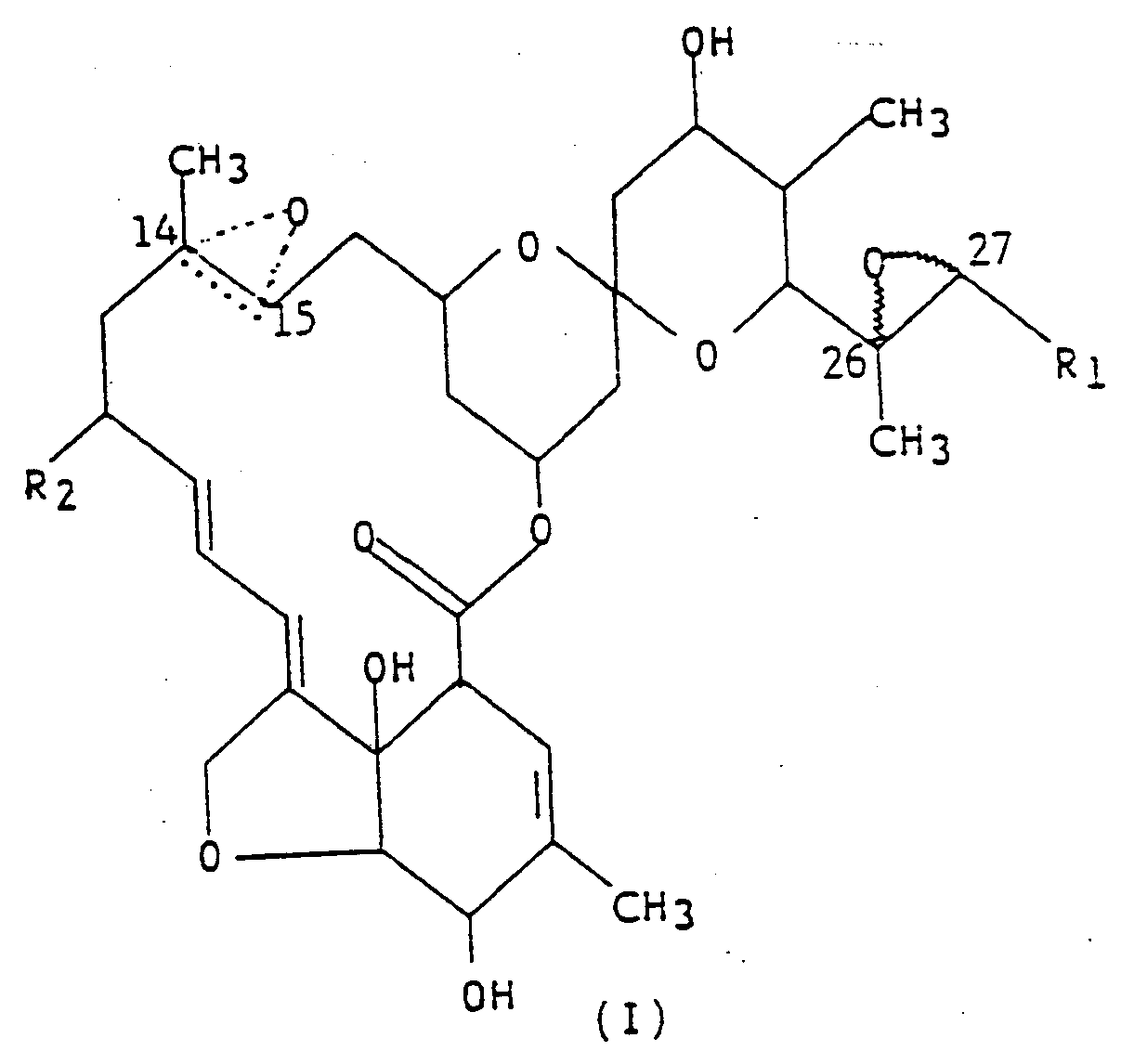
wherein R₁ is methyl or isopropyl; R₂ is hydrogen, or ethyl; the dotted triangular figure with oxygen at C(14,15) indicates that either a double bond or an epoxide is present; and an inert carrier.
wherein R₁ is methyl or isopropyl; R₂ is hydrogen, or ethyl; the dotted triangular figure with oxygen at C(14,15) indicates that either a double bond or an epoxide is present; and an inert carrier.
Patentansprüche für folgende(n) Vertragsstaat(en): AT, BE, CH, DE, FR, GB, IT, LI,
LU, NL, SE
1. Verbindung der allgemeinen Formel (I),
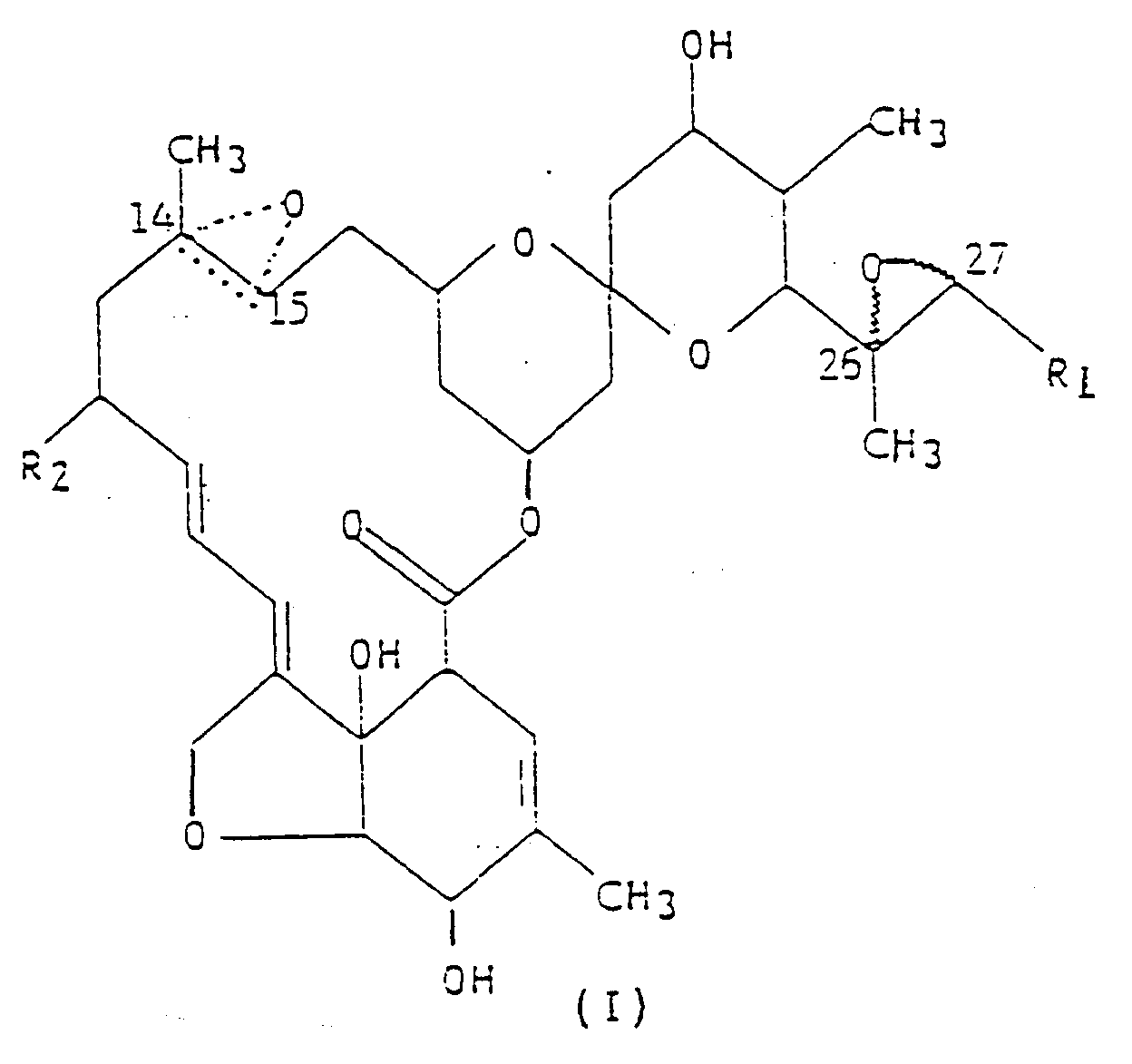
worin R₁ eine Methyl- oder Isopropylgruppe ist; R₂ ein Wasserstoffatom oder eine Ethylgruppe ist; und die gepunktete dreieckige Figur mit einem Sauerstoffatom an C(14,15) bedeutet, daß entweder eine Doppelbindung oder ein Epoxid vorliegt.
worin R₁ eine Methyl- oder Isopropylgruppe ist; R₂ ein Wasserstoffatom oder eine Ethylgruppe ist; und die gepunktete dreieckige Figur mit einem Sauerstoffatom an C(14,15) bedeutet, daß entweder eine Doppelbindung oder ein Epoxid vorliegt.
2. Verfahren zur topischen oder systemischen Bekämpfung von Pflanzeninsekten und zum
Schutz von Feldfrüchten Bäumen, Sträuchern, gelagertem Getreide und Zierpflanzen,
umfassend die Anwendung einer insektizid wirksamen Menge der Verbindung der allgemeinen
Strukturformel (I),

worin R₁ eine Methyl- oder Isopropylgruppe ist; R₂ ein Wasserstoffatom oder eine Ethylgruppe ist; und die gepunktete dreieckige Figur mit einem Sauerstoffatom an C(14,15)bedeutet, daß entweder eine Doppelbindung oder ein Epoxid vorliegt.
worin R₁ eine Methyl- oder Isopropylgruppe ist; R₂ ein Wasserstoffatom oder eine Ethylgruppe ist; und die gepunktete dreieckige Figur mit einem Sauerstoffatom an C(14,15)bedeutet, daß entweder eine Doppelbindung oder ein Epoxid vorliegt.
3. Verfahren zur Bekämpfung von Pflanzennematoden, umfassend die Anwendung einer nematizid
wirksamen Menge der Verbindung der allgemeinen Strukturformel (I),

worin R₁ eine Methyl- oder Isopropylgruppe ist; R₂ ein Wasserstoffatom oder eine Ethylgruppe ist; und die gepunktete dreieckige Figur mit einem Sauerstoffatom an C(14,15) andeutet, daß entweder eine Doppelbindung oder ein Epoxid vorliegt, auf das Blattwerk der Pflanzen, auf den Boden auf dem diese wachsen, oder auf derer Stiele.
worin R₁ eine Methyl- oder Isopropylgruppe ist; R₂ ein Wasserstoffatom oder eine Ethylgruppe ist; und die gepunktete dreieckige Figur mit einem Sauerstoffatom an C(14,15) andeutet, daß entweder eine Doppelbindung oder ein Epoxid vorliegt, auf das Blattwerk der Pflanzen, auf den Boden auf dem diese wachsen, oder auf derer Stiele.
4. Mitte zur Behandlung, Prävention oder Bekämpfung von parasitären Infektionen bei warmblütigen
Tieren, umfassend eine prophylaktisch, therapeutisch oder pharmazeutisch wirksame
Menge der Verbindung der allgemeinen Strukturformel (I),

worin R₁ eine Methylgruppe oder Isopropylgruppe ist; R₂ ein Wasserstoffatom oder eine Ethylgruppe ist; und die gepunktete dreieckige Figur mit einem Sauerstoffatom an C(14,15) andeutet, daß entweder eine Doppelbindung oder ein Epoxid vorliegt; und ein inertes Trägermaterial.
worin R₁ eine Methylgruppe oder Isopropylgruppe ist; R₂ ein Wasserstoffatom oder eine Ethylgruppe ist; und die gepunktete dreieckige Figur mit einem Sauerstoffatom an C(14,15) andeutet, daß entweder eine Doppelbindung oder ein Epoxid vorliegt; und ein inertes Trägermaterial.
5. Mittel zur Bekämpfung von Insekten, umfassend eine insektizid wirksame Menge der Verbindung
der allgemeinen Strukturformel (I),
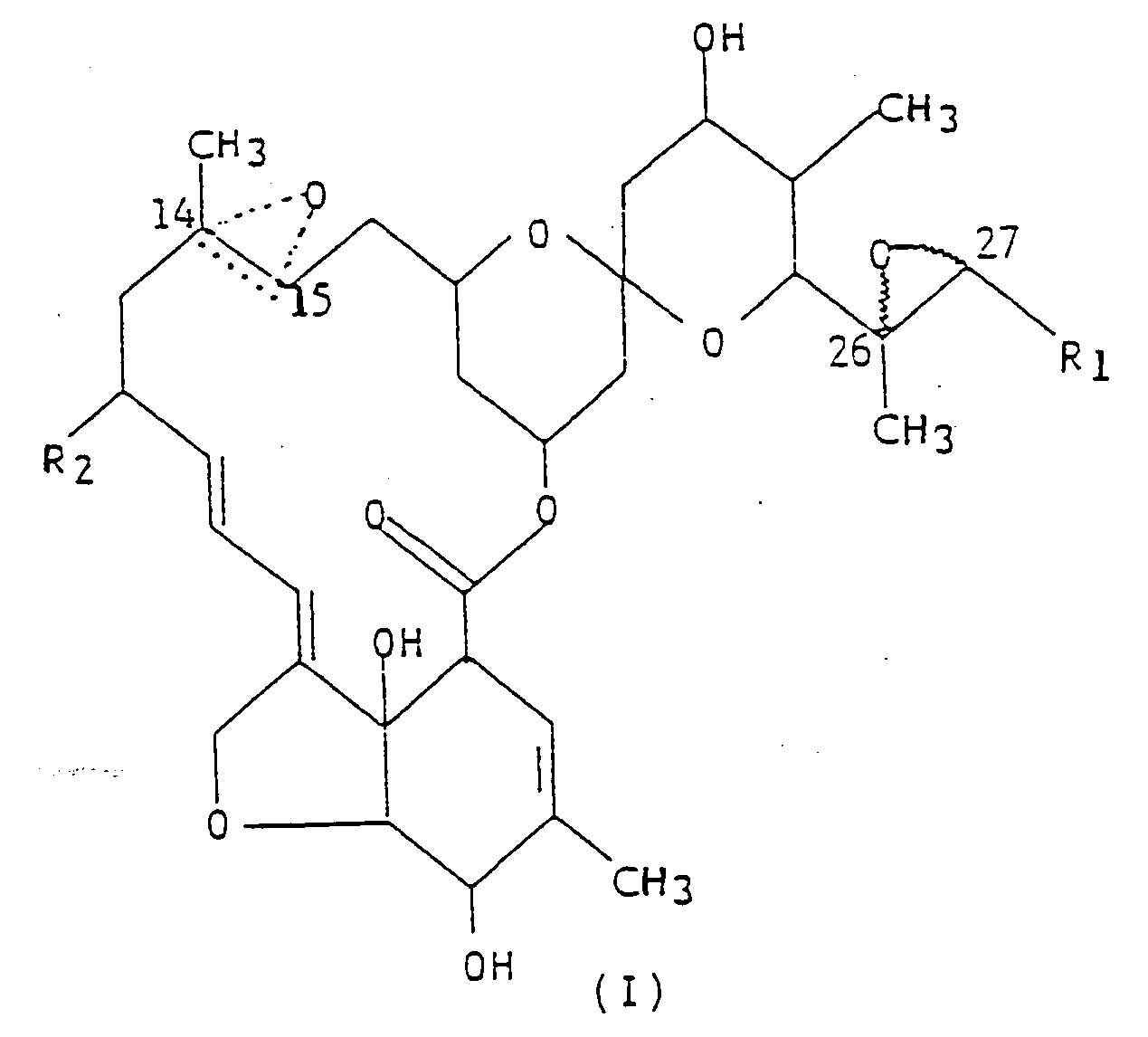
worin R₁ eine Methylgruppe oder Isopropylgruppe ist; R₂ ein Wasserstoffatom oder eine Ethylgruppe ist; und die gepunktete dreieckige Figur mit einem Sauerstoffatom an C(14,15) andeutet, daß entweder eine Doppelbindung oder ein Epoxid vorliegt; und ein inertes Trägermaterial.
worin R₁ eine Methylgruppe oder Isopropylgruppe ist; R₂ ein Wasserstoffatom oder eine Ethylgruppe ist; und die gepunktete dreieckige Figur mit einem Sauerstoffatom an C(14,15) andeutet, daß entweder eine Doppelbindung oder ein Epoxid vorliegt; und ein inertes Trägermaterial.
Patentansprüche für folgende(n) Vertragsstaat(en): ES, GR
1. Verfahren zur Herstellung einer Verbindungen der allgemeinen Formel (I),

worin R₁ eine Methyl- oder Isopropylgruppe ist; R₂ ein Wasserstoffatom oder eine Ethylgruppe ist; und die gepunktete dreieckige Figur mit einem Sauerstoffatom an C(14,15) bedeutet, daß entweder eine Doppelbindung oder ein Epoxid vorliegt,
dadurch gekennzeichnet, daß
eine in geeigneter Weise geschützte LL-F28249-Verbindung in einem inerten Lösungsmittel bei einer Temperatur von weniger als -15°C mit einem Oxidationsmittel behandelt wird, wobei das Oxidationsmittel die C(26,27) Doppelbindung, sowie die C(14,15) Doppelbindung selektiv oxidieren kann aber die anderen Doppelbindungen des Moleküls unversehrt läßt.
worin R₁ eine Methyl- oder Isopropylgruppe ist; R₂ ein Wasserstoffatom oder eine Ethylgruppe ist; und die gepunktete dreieckige Figur mit einem Sauerstoffatom an C(14,15) bedeutet, daß entweder eine Doppelbindung oder ein Epoxid vorliegt,
dadurch gekennzeichnet, daß
eine in geeigneter Weise geschützte LL-F28249-Verbindung in einem inerten Lösungsmittel bei einer Temperatur von weniger als -15°C mit einem Oxidationsmittel behandelt wird, wobei das Oxidationsmittel die C(26,27) Doppelbindung, sowie die C(14,15) Doppelbindung selektiv oxidieren kann aber die anderen Doppelbindungen des Moleküls unversehrt läßt.
2. Verfahren zur topischen oder systemischen Bekämpfung von Pflanzeninsekten und zum
Schutz von Feldfrüchten, Bäumen, Sträuchern, gelagertem Getreide und Zierpflanzen,
umfassend die Anwendung einer insektizid wirksamen Menge der Verbindung allgemeinen
Strukturformel (I),

worin R₁ eine Methyl- oder Isopropylgruppe ist; R₂ ein Wasserstoffatom oder eine Ethylgruppe ist; und die gepunktete dreieckige Figur mit einem Sauerstoffatom an C(14,15) bedeutet, daß entweder eine Doppelbindung oder ein Epoxid vorliegt.
worin R₁ eine Methyl- oder Isopropylgruppe ist; R₂ ein Wasserstoffatom oder eine Ethylgruppe ist; und die gepunktete dreieckige Figur mit einem Sauerstoffatom an C(14,15) bedeutet, daß entweder eine Doppelbindung oder ein Epoxid vorliegt.
3. Verfahren zur Bekämpfung von Pflanzennematoden, umfassend die Anwendung einer nematizid
wirksamen Menge der Verbindung der allgemeinen Strukturformel (I),
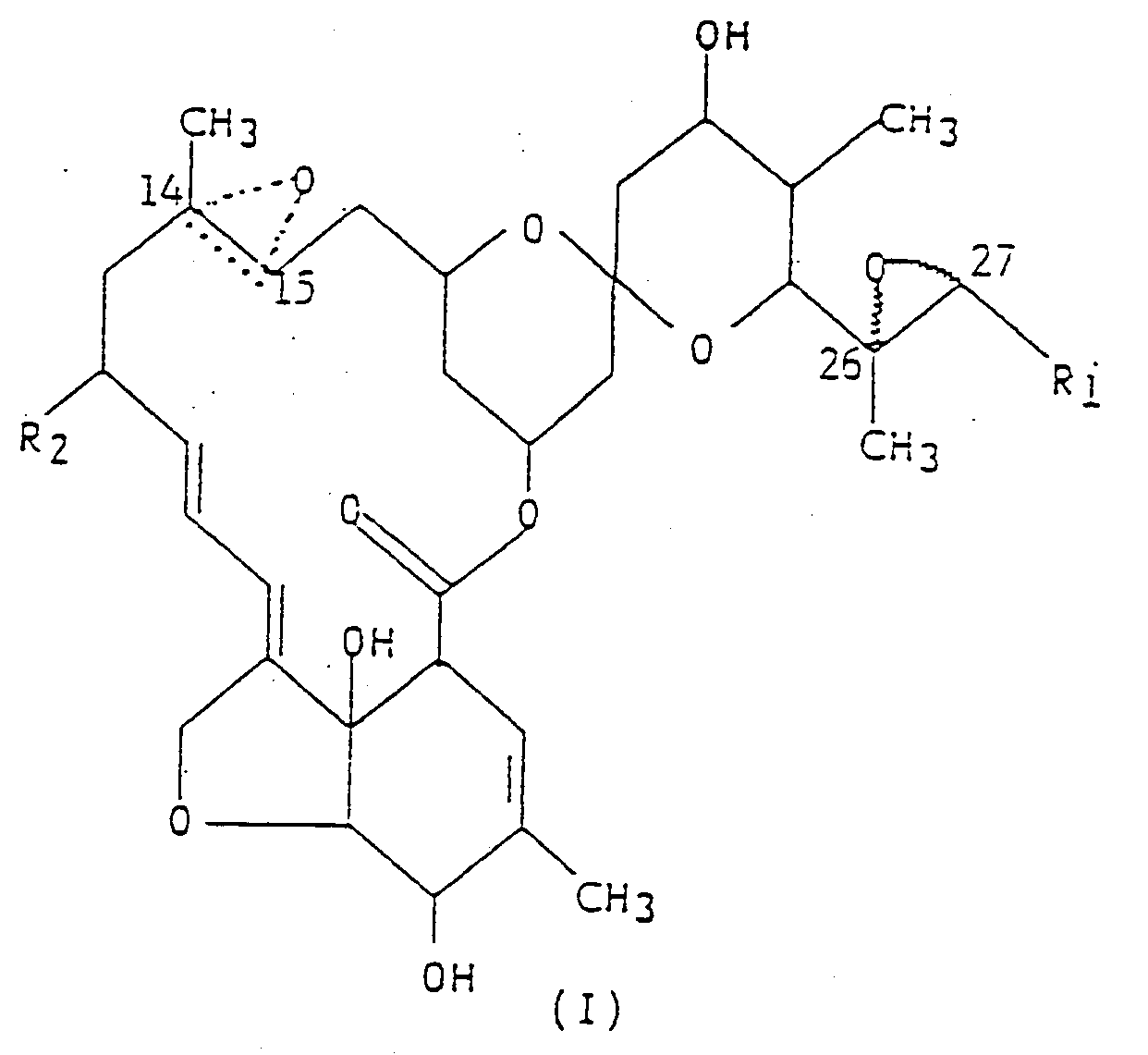
worin R₁ eine Methyl- oder Isopropylgruppe ist; R₂ ein Wasserstoffatom oder eine Ethylgruppe ist; und die gepunktete dreieckige Figur mit einem Sauerstoffatom an C(14,15) andeutet, daß entweder eine Doppelbindung oder ein Epoxid vorliegt, auf das Blattwerk der Pflanzen, auf den Boden auf dem diese wachsen, oder auf deren Stiele.
worin R₁ eine Methyl- oder Isopropylgruppe ist; R₂ ein Wasserstoffatom oder eine Ethylgruppe ist; und die gepunktete dreieckige Figur mit einem Sauerstoffatom an C(14,15) andeutet, daß entweder eine Doppelbindung oder ein Epoxid vorliegt, auf das Blattwerk der Pflanzen, auf den Boden auf dem diese wachsen, oder auf deren Stiele.
4. Mittel zur Bekämpfung von Insekten, umfassend eine insektizid wirksame Menge der Verbindung
der allgemeinen Strukturformel (I),

worin R₁ eine Methylgruppe oder Isopropylgruppe ist; R₂ ein Wasserstoffatom oder eine Ethylgruppe ist; und die gepunktete dreieckige Figur mit einem Sauerstoffatom an C(14,15) andeutet, daß entweder eine Doppelbindung oder ein Epoxid vorliegt; und ein inertes Trägermaterial.
worin R₁ eine Methylgruppe oder Isopropylgruppe ist; R₂ ein Wasserstoffatom oder eine Ethylgruppe ist; und die gepunktete dreieckige Figur mit einem Sauerstoffatom an C(14,15) andeutet, daß entweder eine Doppelbindung oder ein Epoxid vorliegt; und ein inertes Trägermaterial.
Revendications pour l'(les) Etat(s) contractant(s) suivant(s): AT, BE, CH, DE, FR,
GB, IT, LI, LU, NL, SE
1. Composé représenté par la formule (I),

dans laquelle R₁ est un groupe méthyle ou isopropyle ; R₂ est un atome d'hydrogène ou un groupe éthyle ; et la figure triangulaire en pointillés renfermant un atome d'oxygène en C(14,15) indique la présence soit d'une double liaison, soit d'un époxyde.
dans laquelle R₁ est un groupe méthyle ou isopropyle ; R₂ est un atome d'hydrogène ou un groupe éthyle ; et la figure triangulaire en pointillés renfermant un atome d'oxygène en C(14,15) indique la présence soit d'une double liaison, soit d'un époxyde.
2. Procédé de lutte contre les insectes des végétaux, par voie locale ou systémique,
et de protection des cultures, des arbres, des arbustes, des grains stockés et des
plantes décoratives, ledit procédé comprenant : l'application d'une quantité efficace
comme insecticide du composé représenté par la formule développée (I),
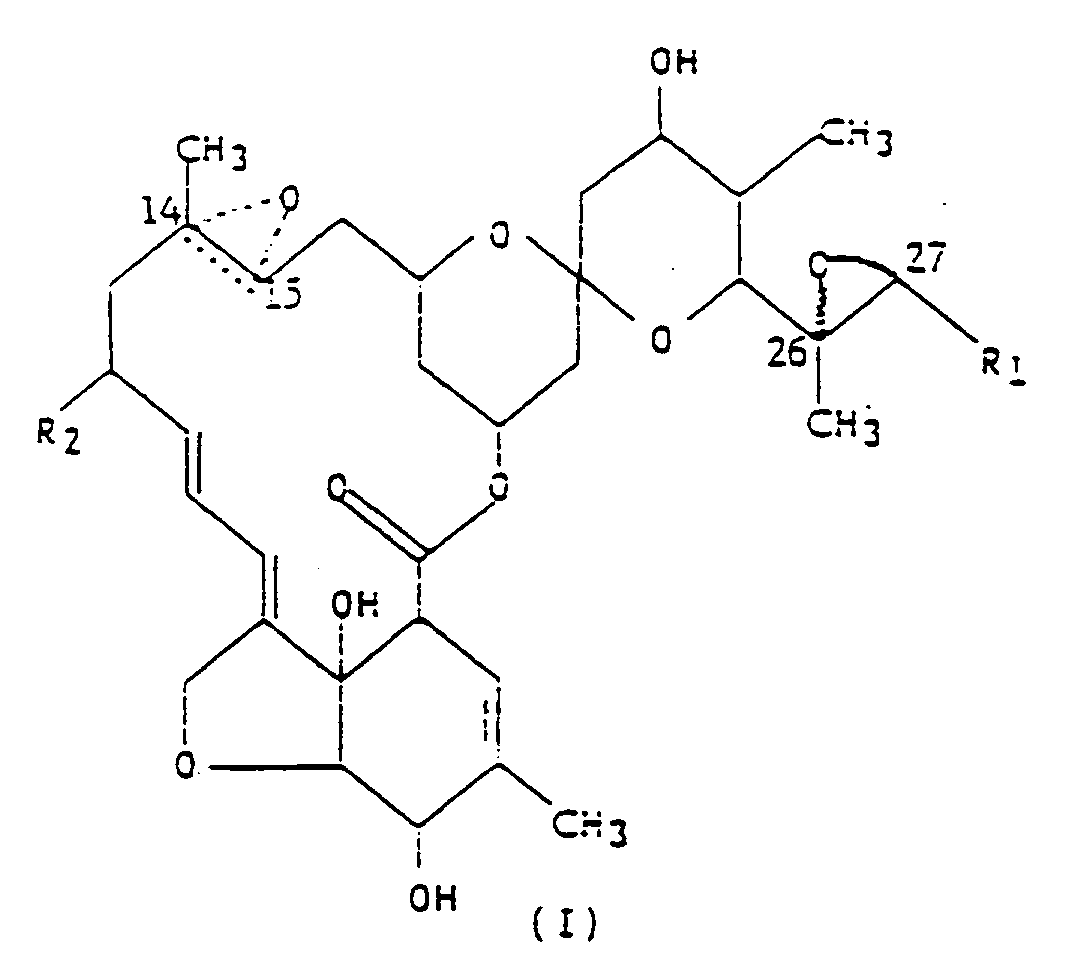
dans laquelle R₁ est un groupe méthyle ou isopropyle ; R₂ est un atome d'hydrogène ou un groupe éthyle ; et la figure triangulaire en pointillés renfermant un atome d'oxygène en C(14,15) indique la présence soit d'une double liaison, soit d'un époxyde.
dans laquelle R₁ est un groupe méthyle ou isopropyle ; R₂ est un atome d'hydrogène ou un groupe éthyle ; et la figure triangulaire en pointillés renfermant un atome d'oxygène en C(14,15) indique la présence soit d'une double liaison, soit d'un époxyde.
3. Procédé de lutte contre les nématodes des végétaux, ledit procédé comprenant : l'application,
sur le feuillage des végétaux, sur le sol sur lequel ils poussent ou dans leurs troncs,
d'une quantité efficace comme nématicide du composé représenté par la formule développée
(I),
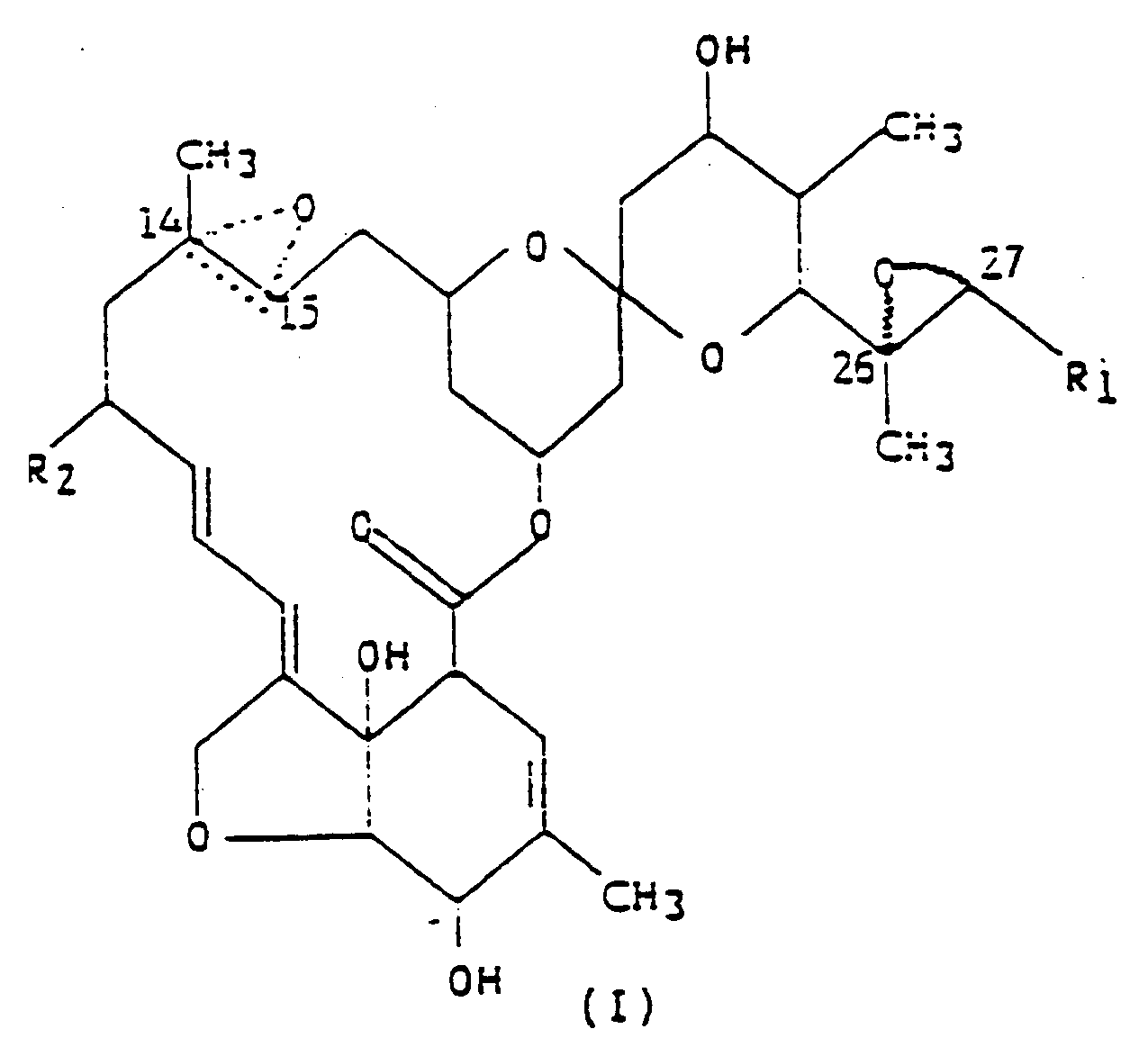
dans laquelle R₁ est un groupe méthyle ou isopropyle ; R₂ est un atome d'hydrogène ou un groupe éthyle ; et la figure triangulaire en pointillés renfermant un atome d'oxygène en C(14,15) indique la présence soit d'une double liaison, soit d'un époxyde.
dans laquelle R₁ est un groupe méthyle ou isopropyle ; R₂ est un atome d'hydrogène ou un groupe éthyle ; et la figure triangulaire en pointillés renfermant un atome d'oxygène en C(14,15) indique la présence soit d'une double liaison, soit d'un époxyde.
4. Composition pour le traitement, la prévention ou la lutte contre les infections parasitaires
chez les animaux à sang chaud, ladite composition comprenant : une quantité efficace
en prophylaxie, en thérapeutique ou en pharmacie du composé représenté par la formule
développée (I),
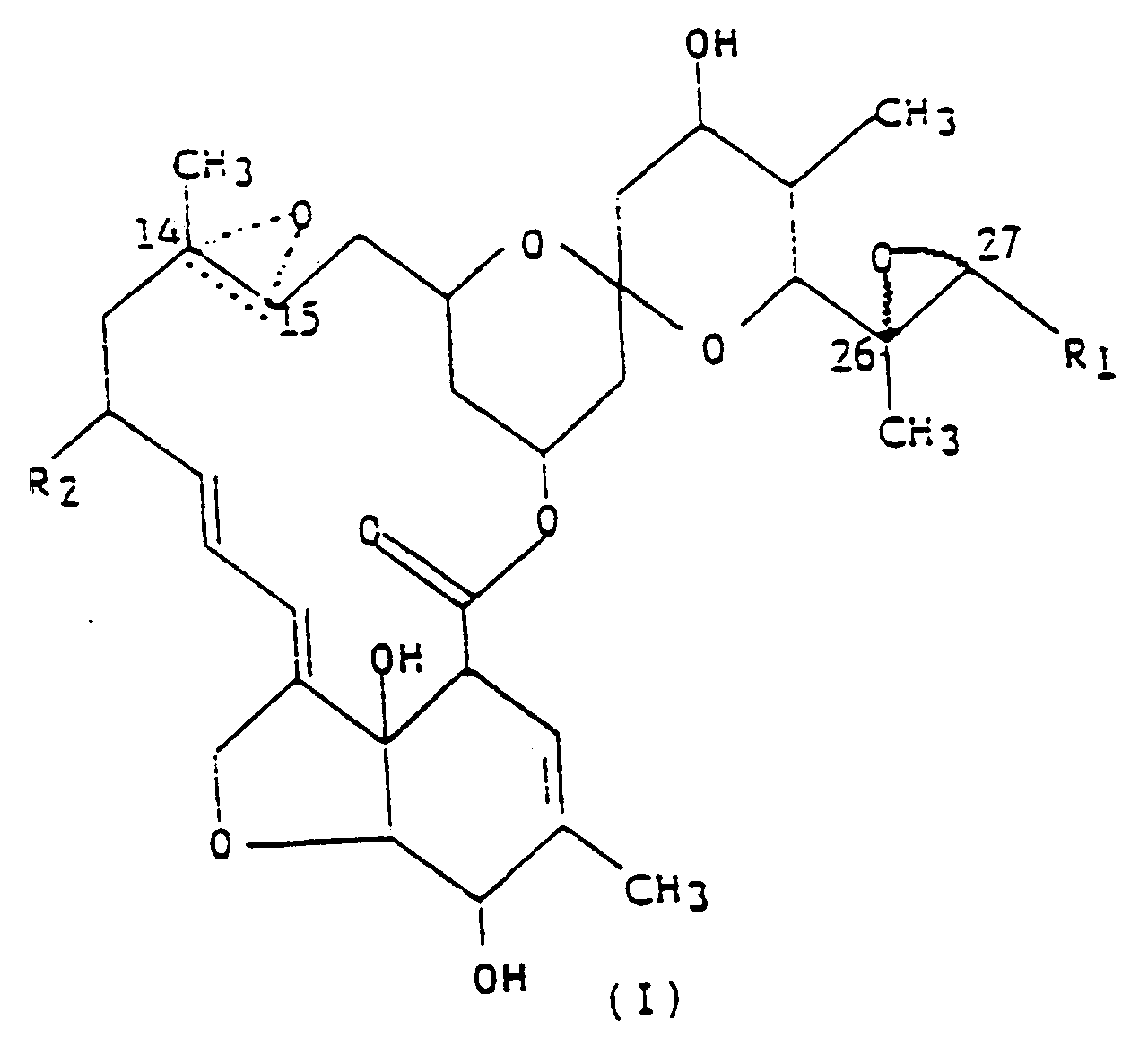
dans laquelle R₁ est un groupe méthyle ou isopropyle ; R₂ est un atome d'hydrogène ou un groupe éthyle ; et la figure triangulaire en pointillés renfermant un atome d'oxygène en C(14,15) indique la présence soit d'une double liaison, soit d'un époxyde ; et un véhicule inerte.
dans laquelle R₁ est un groupe méthyle ou isopropyle ; R₂ est un atome d'hydrogène ou un groupe éthyle ; et la figure triangulaire en pointillés renfermant un atome d'oxygène en C(14,15) indique la présence soit d'une double liaison, soit d'un époxyde ; et un véhicule inerte.
5. Composition de lutte contre les insectes, ladite composition comprenant : une quantité
efficace comme insecticide du composé représenté par la formule développée (I),
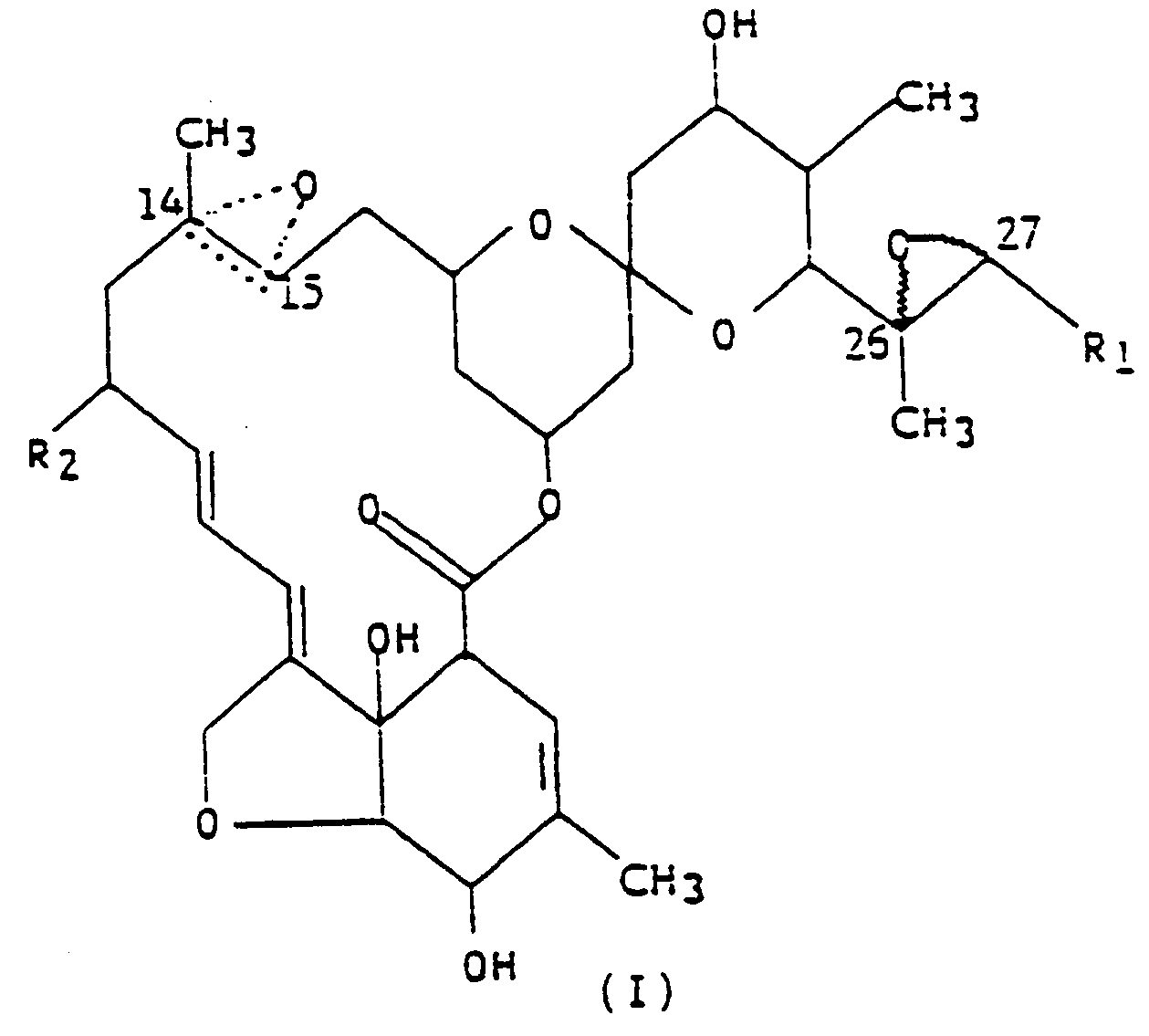
dans laquelle R₁ est un groupe méthyle ou isopropyle ; R₂ est un atome d'hydrogène ou un groupe éthyle ; et la figure triangulaire en pointillés renfermant un atome d'oxygène en C(14,15) indique la présence soit d'une double liaison, soit d'un époxyde ; et un véhicule inerte.
dans laquelle R₁ est un groupe méthyle ou isopropyle ; R₂ est un atome d'hydrogène ou un groupe éthyle ; et la figure triangulaire en pointillés renfermant un atome d'oxygène en C(14,15) indique la présence soit d'une double liaison, soit d'un époxyde ; et un véhicule inerte.
Revendications pour l'(les) Etat(s) contractant(s) suivant(s): ES, GR
1. Procédé de préparation d'un composé représenté par la formule (I),
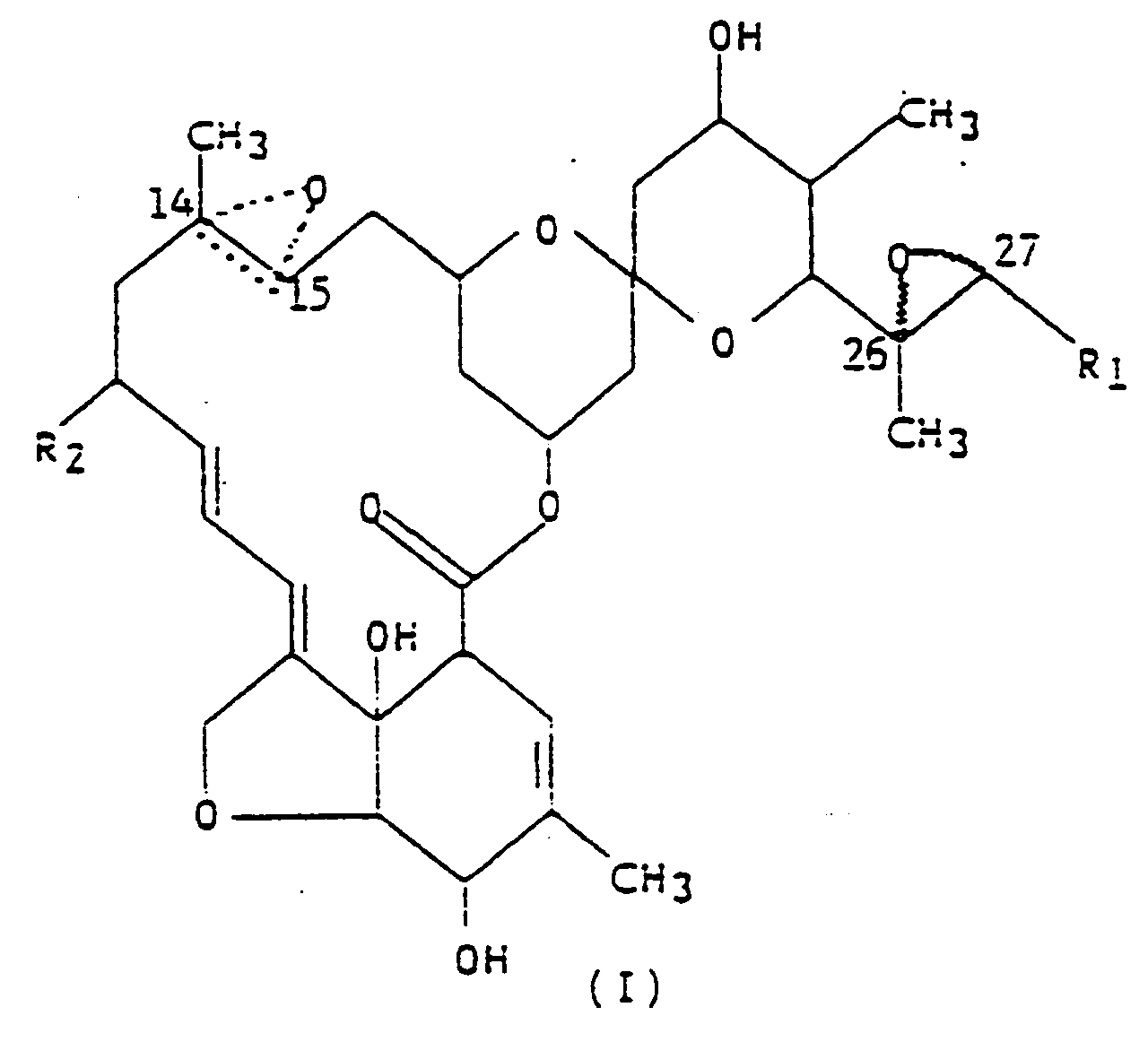
dans laquelle R₁ est un groupe méthyle ou isopropyle ; R₂ est un atome d'hydrogène ou un groupe éthyle ; et la figure triangulaire en pointillés renfermant un atome d'oxygène en C(14,15) indique la présence soit d'une double liaison, soit d'un époxyde, caractérisé en ce que l'on traite le composé LL-F28249 protégé de façon adéquate avec un agent oxydant, à une température inférieure à -15°C, dans un solvant inerte, avec un agent oxydant capable d'oxyder sélectivement la double liaison en C(26,27), ainsi que la double liaison en C(14,15), tout en laissant intactes les autres doubles liaisons de la molécule.
dans laquelle R₁ est un groupe méthyle ou isopropyle ; R₂ est un atome d'hydrogène ou un groupe éthyle ; et la figure triangulaire en pointillés renfermant un atome d'oxygène en C(14,15) indique la présence soit d'une double liaison, soit d'un époxyde, caractérisé en ce que l'on traite le composé LL-F28249 protégé de façon adéquate avec un agent oxydant, à une température inférieure à -15°C, dans un solvant inerte, avec un agent oxydant capable d'oxyder sélectivement la double liaison en C(26,27), ainsi que la double liaison en C(14,15), tout en laissant intactes les autres doubles liaisons de la molécule.
2. Procédé de lutte contre les insectes des végétaux, par voie locale ou systémique,
et de protection des cultures, des arbres, des arbustes, des grains stockés et des
plantes décoratives, ledit procédé comprenant : l'application d'une quantité efficace
comme insecticide du composé représenté par la formule développée (I),

dans laquelle R₁ est un groupe méthyle ou isopropyle ; R₂ est un atome d'hydrogène ou un groupe éthyle ; et la figure triangulaire en pointillés renfermant un atome d'oxygène en C(14,15) indique la présence soit d'une double liaison, soit d'un époxyde.
dans laquelle R₁ est un groupe méthyle ou isopropyle ; R₂ est un atome d'hydrogène ou un groupe éthyle ; et la figure triangulaire en pointillés renfermant un atome d'oxygène en C(14,15) indique la présence soit d'une double liaison, soit d'un époxyde.
3. Procédé de lutte contre les nématodes des végétaux, ledit procédé comprenant : l'application,
sur le feuillage des végétaux, sur le sol sur lequel ils poussent ou dans leurs troncs,
d'une quantité efficace comme nématicide du composé représenté par la formule développée
(I),
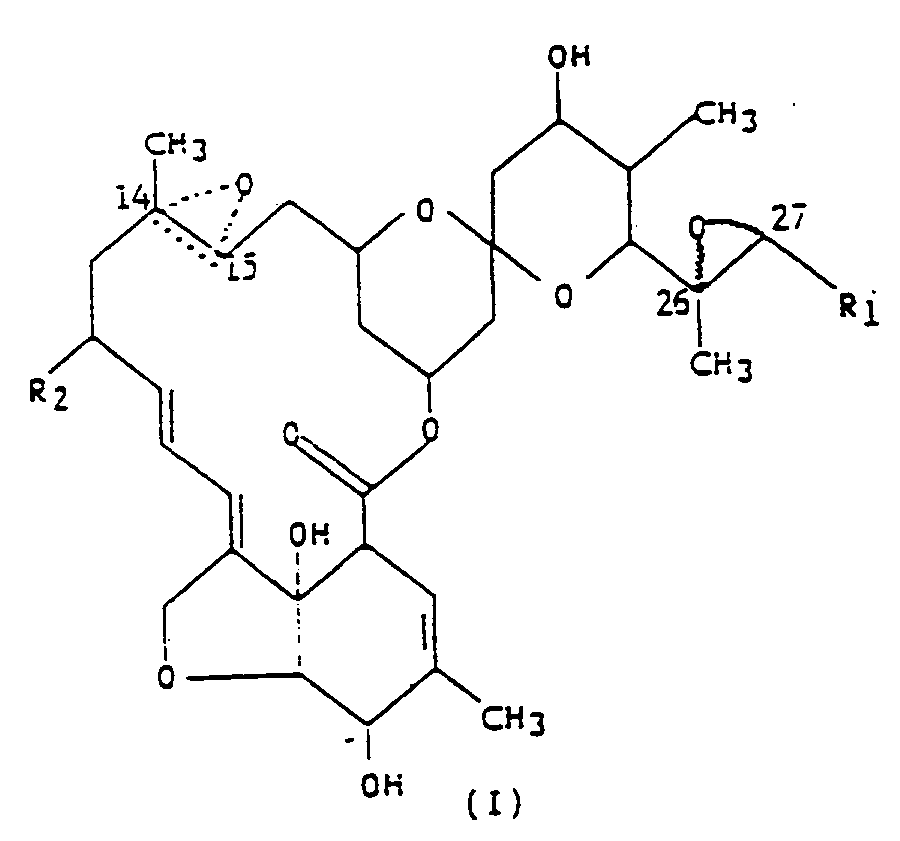
dans laquelle R₁ est un groupe méthyle ou isopropyle ; R₂ est un atome d'hydrogène ou un groupe éthyle ; et la figure triangulaire en pointillés renfermant un atome d'oxygène en C(14,15) indique la présence soit d'une double liaison, soit d'un époxyde.
dans laquelle R₁ est un groupe méthyle ou isopropyle ; R₂ est un atome d'hydrogène ou un groupe éthyle ; et la figure triangulaire en pointillés renfermant un atome d'oxygène en C(14,15) indique la présence soit d'une double liaison, soit d'un époxyde.
4. Composition de lutte contre les insectes, ladite composition comprenant : une quantité
efficace comme insecticide du composé représenté par la formule développée (I),

dans laquelle R₁ est un groupe méthyle ou isopropyle ; R₂ est un atome d'hydrogène ou un groupe éthyle ; et la figure triangulaire en pointillés renfermant un atome d'oxygène en C(14,15) indique la présence soit d'une double liaison, soit d'un époxyde ; et un véhicule inerte.
dans laquelle R₁ est un groupe méthyle ou isopropyle ; R₂ est un atome d'hydrogène ou un groupe éthyle ; et la figure triangulaire en pointillés renfermant un atome d'oxygène en C(14,15) indique la présence soit d'une double liaison, soit d'un époxyde ; et un véhicule inerte.
